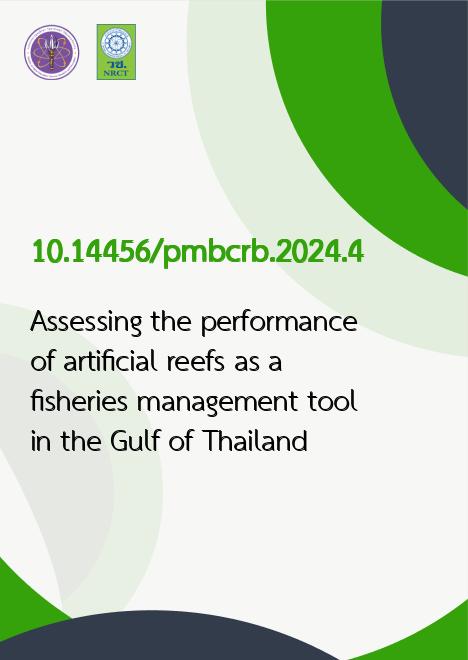
|
Assessing the performance of artificial reefs as a fisheries management tool in the Gulf of Thailand |
|---|---|
| รหัสดีโอไอ | |
| Creator | Piers Baillie |
| Title | Assessing the performance of artificial reefs as a fisheries management tool in the Gulf of Thailand |
| Contributor | Gavin Miller, Getsamol Chaona |
| Publisher | Phuket Marine Biological Center |
| Publication Year | 2567 |
| Journal Title | Phuket Marine Biological Center Research Bulletin |
| Journal Vol. | 81 |
| Journal No. | 1 |
| Page no. | 75-92 |
| Keyword | Artificial Reefs, Fisheries Management, Fish Communities, Functional Groups, Conservation, Coral Reefs, Habitat Complexity |
| URL Website | https://km.dmcr.go.th/c_266 |
| Website title | PMBC Research Bulletin |
| ISSN | 2697-6323 |
| Abstract | This study assesses the effectiveness of artificial reefs as fisheries management tools in the Gulf of Thailand, a region with high levels of fishing and tourism. Fish assemblages representing various functional groups and trophic levels, were compared between two artificial and two natural reefs. Fish abundance data was collected using underwater visual censuses during timed-swim surveys, covering an approximate area of 1,200 m² per transect. Surveys yielded a total of 12,522 fish countsfrom 68 transects. Statistical analyses were performed to investigate site-specific community structures and habitat preferences. These revealed significant compositional dissimilarities, both amongst and between reef types. Lutjanus, Diagramma and Plectorhinchus showed a preference towards artificial reefs, indicating the potential value of artificial reefs in supporting mid-trophic species of economic importance to fisheries. Conversely, Labroides and Hemigymnus favoured natural reefs, suggesting possible limitations of artificial reefs in supporting entire reef ecosystems. Lutjanus also exhibited a strong preference towards shipwrecks over concrete structures, possibly highlighting the importance of unique structural design and material in influencing species distribution. This study highlights the necessity of considering ecological characteristics, target species and deployment objectives of future artificial reefs. Although they may benefit certain valuable species, their role in maintainingbiodiversity is limited, reinforcing the need for natural reef conservation. This research offers insight into the role of artificial reefs as fisheries management tools, acting as potential habitat refuge, whilst also highlighting the importance of strategic planning and further research for enhancing their ecological and conservation effectiveness in the Gulf of Thailand. |